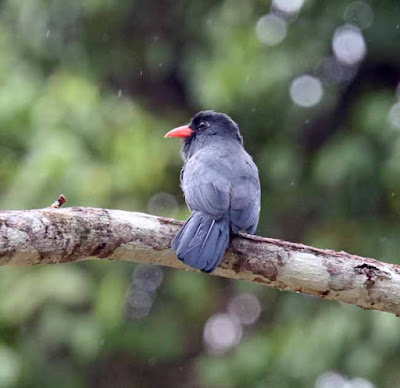I finally made it back to Colombia for my second visit and again used the guide services of Pablo Florez. I went with my friend Martin Jackson. We visited Inirida on the Orinoco, Santa Marta of course, Guajira Peninsula on the Caribbean coast, and a couple of National Parks around Bogota.
Wrens are a modest sized family of 88 species - all but 1 are in the New World. Despite being mostly brown birds - they are very active and cute with their usually uplifted tails. Many of the species are a challenge to see, let alone photograph. That is another trait that makes them a favorite family of birds for me. Every time I photo a new species, I am very happy.
I photographed 4 new species and another one that is a likely split. All were lifers.
The easiest ID is the beautiful 7.5" Bicolored Wren (Campylorhynchus griseus).
 |
| Bicolored Wren |
His cousin is the 7.5" Thrush-like Wren (Campylorhynchus turdinus). It is a brown-backed wren with a spotted breast.
 |
| Thrush-like Wren |
The Grey-breasted Wood Wren complex contains many likely splits in various geographic areas. 2 of these are in Santa Marta and are endemic to Colombia.
The 4.25" Hermit Wood Wren (Henicorhina anachoreta) is found above 2000m elevation in Santa Marta mountains. When it was first split from the Grey-breasted Wood Wren complex, it was called Santa Marta Wood Wren.
 |
| Hermit Wood Wren |
The 4.25" Bangs' Wood Wren (Henicorhina bangsi) has not been officially split yet, but does show as a split in the Birds of Columbia Field Guide, so I am sure it will be officially split soon. It is found between 1000 - 2000m elevation in the Santa Marta range. I was so happy to get both of these wrens on the one morning we had a chance to see them.
 |
| Bangs' Wood Wren |
The 4" Apolinar's Wren (Cistothorus apolinari) is a resident around lakes in the paramo above Bogota. It took about 20 minutes of frustration as he moved around rapidly, before I got a photo. He is endemic to Colombia
 |
| Apolinar's Wren |
In keeping with the small birds, manakins are another very small family of New World songbirds. I photographed 3 on the trip and all were life birds.
 |
| Black Manakin - female |
The 5" male Lance-tailed Manakin (Chiroxiphia lanceolata) is black , with a blue back, a red crown (here raised like a crest) and a few elongated tail feathers.
 |
| Lance-tailed Manakin - male |
Lastly is the 4.5" male White-bearded Manakin (Manacus manacus). He has a black crown, back, wings and tail and the underparts are white. He has red legs. This bird just sat for maybe 20 minutes and I got this one photo showing the beard extended. It was an exciting encounter, even though the guide book says it may be the most frequently seen manakin in Colombia due to its extensive range.
 |
| White-bearded Manakin - male |
I put the different bird/mammal families in single folders for easy viewing
David McDonald
dkmmdpa@gmail.com
photos copyright 2006 - 2022 David McDonald
To have these trip reports sent to your email, please email me at the above address and ask to subscribe.







